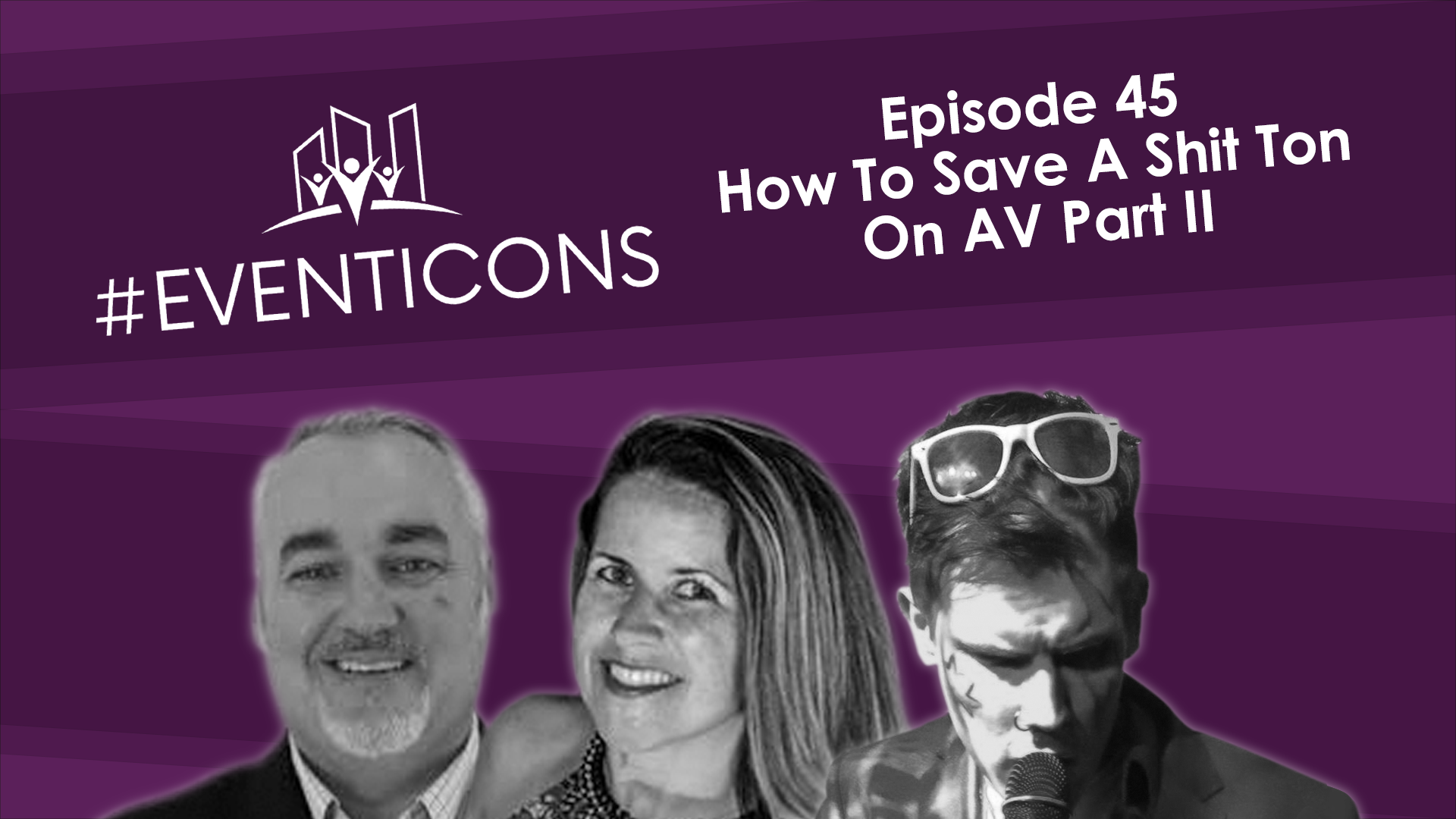This week we’re wrapping up our 2-part series focused on how to understand and minimize the cost of AV for events. Bring your questions for our panelists! We’re being joined by the iconic Damian Oracki, Tommy Melancon, and Megan Powers. What a lineup! Topics for today’s episode will include why the cost of AV is often so high, how can planners save money on AV, and what are some hidden AV costs to be aware of.
Our guests will be addressing these questions and more as they share their years of experience and expertise. We’re unveiling the mysteries of the cost of AV, so wait no longer and press play. We’re going off on one of our most interesting journeys yet!

The Cost Of AV: Why So Expensive?
Will wants to hear our guests’ take on why AV is so expensive. “I mean it’s a misconception. It is expensive because it’s a big chunk of the budget, but there’s a lot”, says Damian. “As you know yourself, first the equipment costs, right? Actually owning the equipment yourself, as in the AV company, owning the equipment or hiring it from another AV company costs. But then it’s also the storage of it, the maintenance of it, the logistics of it, the crew to unload and load, to set up. And then obviously the operating costs, actually using the gear on site. So I mean there’s a lot to it, it’s not just bang, and if it’s in-house it’s in-house. But if it’s a bit of kit to come in, then there’s no doubt why it would cost a lot”.
The Cost Of Labor
“Bear in mind it is a professional job, so there is a standard rate”, adds Damian. “But there’s also a markup attached to it, as you know. The work involved. Let’s be honest, being a lighting designer is not as easy as it looks. You can watch those guys sweat while they’re mixing the lights. Depending on what the gig is, it’s quite a stressful job. Because it’s live, and they make a mistake, then it’s on them. Sometimes obviously the guests don’t notice, because they don’t notice what’s actually happened. But professionals do notice, and they are good at what they do for a reason”.
“There is equipment. There is labor. You have to consider, even if you’re only a half-day, that video engineer gave up an entire day that he could have worked for someone else to work for you”, says Megan. “So you have to pay him for a full day. And labor is the biggest cost. If you have 20 people in a room, that’s a different story than if you have 3,000 people. And everyone needs to hear and see everything that’s going on on stage. But I think at the bottom line, it’s all about communication, and upfront, talking with your AV companies about what you’re trying to accomplish”.
Minimizing The Cost Of Av
“I think the most important part is, before you engage any suppliers or any team that’s going to cost money on your budget or your event, really do the core planning”, says Tommy. “When, where, why, how. Put a good schedule together so you have a clear schedule of when you have access to the venue, what’s the load-in parameters, understanding what your needs are. Because if you think about it, AV suppliers are doing show after show. And if you want a quote from them, the more information you could give, the better chance you get to get real numbers from them. And it goes through the entire flow of the project”.
“Because if you’re starting with a project and you don’t know where it is, you don’t know the exact dates, you don’t know how many show days, that’s a lot of guessing work that you’re just going to extend that to the entire team”, he adds. “And the numbers are going to be vastly different if you’re getting quotes from suppliers because everyone’s going to make assumptions. The least assumptions you bring the less they make, the more accurate your numbers are going to be”.
The Art Of Negotiating
“Of course planning and communication and being detail orientated, getting the right brief”, says Damian. “But also, with what I’ve seen and what we do right now is all about negotiation, and bringing price down, and positive influence. But the whole thing is now if you’re procuring a supplier and you doing this event and it’s an annual event, you should use the powers that you have to bring down the cost”.
“So you’re talking to the supplier and you say look, we want you to be our preferred supplier. You start using that power and talk about using them a lot more and you can actually leverage that to bring the price down. So you can leverage the power of what you have. Now if it’s one social event then make it work for you. But I find that actually can bring the cost down”.
Data Is Your Friend
“You know, everybody talks about in the industry, you’ve heard the big terms over the years, big data”, says Tommy. “Well, we have an opportunity, whether an event planner is doing three shows a year, or 200 shows a year, you have data over those shows that you could use to your advantage. For example, you know, who are the suppliers you are using the most. And which suppliers you should leverage. You should have that data inside of your company or your organization that you’re planning events for, because to me that’s the most important thing”.
“We hear that a lot when we’re working with agencies”, he adds. “They might want to look at the budget line item, and they want to take it off the tech costs, meaning all of the AV, staging, scenic, and labor. Well, that’s fine. But it’s good to know the numbers, and who you want to work with. If you’re going to ask for a deal from a supplier, what does that relationship look like? Are you giving them the kind of work that warrants the kind of discount you’re requesting for this one time?”.
The Role Of Internet In The Cost Of AV
“Internet is the biggest thing that people feel like they’re getting gouged on”, says Megan. “I think it’s the biggest opportunity for a venue to be a hero instead of just charging what they can charge because they can. We don’t need to get into a whole in-house versus out-of-house discussion. But there are definitely advantages that are being taken there. I think that it’s up to the planning community to sort of stand together and be firm in those negotiations. I know that AV companies are losing business. The small guys are losing business because the in-house is packaging that internet with the AV. And really sort of handcuffing them to using the in-house”.
“It’s not just about numbers”, she adds. “It’s about familiarity with your show and the trust level that you have with this AV company that may be traveling with you. If they’ve been doing five shows with you a year for 10 years, and suddenly they’ve got a $40,000 disparity in their budget, that planner may end up feeling like they have to use the in-house, and then they’re sort of starting over. I think the internet’s a big opportunity. And there are outside companies that you can use”.
Run Throughs & Rehearsals
“How do you determine when it’s a good idea to do a run-through or rehearsal? Obviously, it adds things like labor costs and things like that to it. But when do you really need to have a rehearsal with your AV company or a tech run through?”, Will asks. “I think one of the first important things, depending on the scale and size of your show. If you have an opening performance, or you have production aspects, like a large opening that requires a lot of technical teams between departments, you need to do a rehearsal. You need to schedule that time within your budget and the schedule of the event prior to the show”, says Tommy.
“My suggestion is making sure you have that big enough gap too”, adds Will. “So talking to your AV company and saying like this is what we’re trying to do. You know, we’ve had it where they do one session and they’re like all right, now we’re going to bring a band on, and we’re like, well, we need time to soundcheck, yeah, do all that sort of stuff”.
“Or, for example, unfortunately very common now, is we’re getting a lot of people who rent out like one gigantic ballroom and then air wall it and then are separating and rejoining rooms. And they expect transitions to happen like that. So making sure that if you are doing any sort of transitions that you have that time built-in. And that you’re also not doing it, big cost-saver here, during things like lunch breaks or dinner breaks. Because that’s when you get into overtime and added costs as well”.
The Basics Of Labor Rules
“The rule of thumb is pretty straight forward”, says Tommy. “The common rules to follow, if you’re just building a document, is 5-hour blocks between meals. If he’s starting a schedule at 6:00 in the morning, those first couple of hours are probably on time and a half. If he’s starting at 8:00 call or 7:30 call those are typically starting on regular time. You need to watch, after a 10-hour day you start going into overtime, with the union a lot of times that’s eight hours”.
“So you need to think about how you’re planning your day when you hit eight hours. A lot of times, your local labor component starts to go into time and a half. After 12 hours you’re typically in double time. And then the last part to watch out towards the end of that is short-term. Meaning there are rules. The typical rule is eight hours rest period between the next call. Some areas are now nine hours, so you have to have a rest between the call the day before into the call the next day. If you don’t have that rest period everyone starts in short-term, which is double time starting that day. So that could really eat your budget fast in labor”.
To Reduce The Cost Of AV…
“The bottom line is to really understand the rules that you’re working in”, adds Tommy. “Understanding the labor that you’re dealing with, and to set your schedule to benefit the show. And again, get the team on board with that. Because nobody, there’s not many people that want to be working short-term, or working at 2:00 in the morning. But, if that’s what is the need of the show everyone will do it. So again, it’s planning your schedule to work”.
Creative Ideas To Lower The Cost Of AV
“One of the things we’ve been doing a lot more in some events is quiet headsets”, says Tommy. “When you’re running out of space and there is a large breakout? Let’s say you have a lot of breakouts, and they’re over attended. What we’ve been doing is instead of creating a lot of overflow rooms or directing people to multiple places, we do one large ballroom, set up with multi-screens, smaller screens. And each screen has basically red, green, blue color. You get a headset when you walk in, and you could sit and you could watch that program and then switch to red, green, or blue”.
“A couple of other things too is, you mentioned a projection mapping”, he adds. “There’s a lot of technology now that’s getting pretty sophisticated. That is, you could do the switching and the digital media in one platform as opposed to multiple platforms. It’s a pretty new technology, so again, caution. You’ve got to really plan your show. It’s got to be in a sense a very much a straightforward timeline type of show. But there is the capability to save both in crewing and core positions”.
The Cost of AV: It’s About The Details
“It’s the small things“, says Damian. “Instead of being extravagant and using LED walls, with the 62-centimeter panels, projection is as much as a good and easy substitute for that. And there are more things like the backdrop. Instead of using set, you’d use star cloth. You know, there are very easy fixes for the set and stage, to be honest. It’s little things. I’ve seen events where they actually find more out about the event. So if they’ve got a presenter, do they really need a wireless mic, they’d rather use podium mikes, so you know, little things like that actually”.
“It’s a great point”, says Tommy. “Because so often, the team is trying to say we have all of these needs so we’re going to set up all the rooms, where if you have 20 breakouts on level one, set up one room as a really high-end produced room, that’s ready for camera, ready for broadcast, or any of those experiences. And that’s the room you put those high-level events, where that’s the CEO or marketing team having a discussion. You put them in that room, you don’t have to set up all of those rooms as produced rooms, you could just do one produced room on that level”.
Another Shoutout To Communication
“Mine just goes back to upfront communication”, says Megan. “It’s shocking to me how little communication goes on between salespeople and planners or producers. And as somebody who just recently was a buyer, from creative companies for a trade show, there are some basic practices that need to happen regarding communication from both ends that I think aren’t necessarily happening. I had some really bad, like four bad experiences with salespeople in the same week as a buyer”.
“As a planner, as somebody who is buying these services, I think overcommunication is crucial”, she adds. “And not assuming things about your speakers. Because that’s happened to me too. They don’t get the speaker right, or until later, and then the planner is getting that directly, and not communicating. So you have a speaker that shows up for a planner meeting with a Mac, wants to use his own computer, and he needs an internet connection and neither of those things were shared with the venue or with the AV company. I mean, those are huge, and so understanding upfront who is responsible for making sure that everyone understands all of those needs and all of that, that’s big”.
Conclusions
And that’s a wrap on another amazing edition of #EventIcons! Plus, our series on the cost of AV is officially done. Do you feel like you know all you need to know about it? Make sure you check out the resources section below to become an even bigger expert. And don’t forget to tune in again next week for another set of iconic guests and conversations!
Epic resources mentioned:
Watch Out for Hidden Venue Costs










